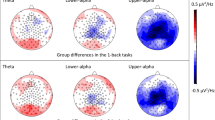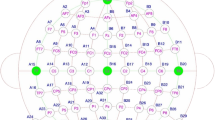Abstract
The hypothesis that in developmental dyslexia the integration of visually presented information and language processing is dysfunctional is tested. Results of processing visually presented letter strings during EEG recordings are presented. The task difficulty of the letter strings was standardised individually and automatically by a computer program. EEG was recorded during rest conditions and different levels of reading performance. 30 developmental dyslexic boys who met the Denckla criteria of “dyslexia pure” and 28 matched control subjects were investigated. The main replicated results were: (1) There was a delay in dyslexic children in processing visually presented letter information, (2) there was no deficit in sustained attention in developmental dyslexics, (3) increasing cognitive activation and reading performance resulted in a faster attenuation of relative alpha power in dyslexics compared to controls, and (4) the dyslexic group did not reveal characteristic focal EEG features when task difficulty was standardised individually.
Résumé
On teste h'hypothèse que dans la dysléxie développementale, le traitement cérébral du langage et de l'intégration de l'information visuelle présentée est dysfonctionnelle.
Les résultats du traitement cérébral des flux de lettres présentés visuellement pendant l'enregistrement EEG sont rapportés. Le degré des difficultés de cette tache est standardisée individuellement et automatiquement par un programme informatisé. L'EEG était enregistré pendant les conditions de repos et différents niveaux de performance de lecture. 30 garçons présentant une dysléxie développementale qui répondaient aux critères Denckla de dyslexie pure et 28 sujets de contrôle appariés furent étudiés Les principaux résultats sont les suivants:
-
1)
Il esistait un retard chez les enfants dysléxiques dans le traitement cérébral de l'information visuelle présentée par des lettres.
-
2)
Il n'y avait pas de déficit dans le maintien de l'attention chez les dysléxiques.
-
3)
L'activation cognitive croissante et les performances de lecture ont montré une atténuation plus rapide de pouvoir alpha relatif chez les dysléxiques comparés au groupe témoin.
-
4)
Le groupe dysléxique ne montrait pas de traits focaux caractéristiques à l'EEG focalisé quand la difficulté de la tâche était standardisée individuellement.
Zusammenfassung
In dieser Arbeit wird die Hypothese getestet, wonach die Integration visuell vorgegebener Informationen und sprachlicher Informationen bei Kindern mit einer Legasthenie gestört ist. 30 Jungen mit einer Legasthenie, die den Kriterien von Denckla für “Dyslexia pure” entsprachen, und 28 Kinder einer Kontrollgruppe, die nach sozialem Status und Intelligenz parallelisiert waren, wurden mittels einer Versuchsanordnung untersucht, die den Vergleich sprachlicher und nicht-sprachlicher visuell vorgegebener Informationen erforderte. Dabei konnte die Schwierigkeit der Aufgabe systematisch individuell und automatisch durch ein Computerprogramm gesteuert werden.
Die wichtigsten Ergebnisse waren: (1) Es zeigte sich ein deutliches Defizit der legasthenen Kinder bei der Verarbeitung visuell präsentierter Buchstaben. (2) Es zeigte sich keine Einschränkung der Daueraufmerksamkeit bei den Kindern mit Legasthenie. (3) Mit zunehmender kognitiver Leistungsanforderung durch visuell vorgegebene Stimulation ergab sich eine stärkere Aktivierung der legasthenen Kinder im Vergleich zur Kontrollgruppe, gemessen in Form einer Alphareduktion im EEG. (4) Die legasthenen Kinder zeigten keine charakteristischen topographischen EEG-Veränderungen, wenn der Schwierigkeitsgrad individuell variiert wurde.
Similar content being viewed by others
References
Achenbach, T.B., & Edelbrock, C. (1983).Manual for the Child Behavior Checklist and Revised Child behavior Profile. Burlington: University of Vermont.
Bente, D., Frick, K., Scheuler, W., & Zeller, G. (1976a). Psychophysiologische Studien zum Verhalten der hirnelektrischen Wachaktivität bei definierter Vigilanzbeanspruchung. 1. Mitteilung: d2-Aufmerksamkeits-Belastungs-Test und EEG Verhalten.Zeitschrift für EEG und EMG, 7, 163–170.
Bente, D., Frick, K., Scheuler, W., & Walz, L. (1976b). Psychophysiologische Studien zum Verhalten der hirnelektrischen Wachaktivität bei definierter Vigilanzbeanspruchung. 2. Mitteilung: Das himelektrische Verhalten bei visuo-motorischen Regelaufgaben steigenden Schwierigkeitsgrades.Zeitschrift für EEG und EMG, 7, 171–176.
Bouma, H., & Legein, Ch. P. (1977). Foveal and parafoveal recognition of letters and words by dyslexics and by average readers.Neuropsychologica, 15, 69–80.
Bouma, H., & Legein, Ch.P. (1980). Dyslexia: A specific recording deficit? An analysis of response latencies for letters and words in dyslectics and in average readers.Neuropsychologia, 18, 285–298.
Broman, M., Rudel, R., Helfgott, E., &Krieger, J., (1985). Inter- and intrahemispheric processing of visual and auditory stimuli by dyslexic children and normal readers.International Journal of Neuroscience, 26, 27–38.
Broman, M., Rudel, R. G., Helfgott, E., & Krieger, J. (1986). Inter- and intrahemispheric processing of letter stimuli by dyslexic children and normal readers.Cortex, 22, 447–459.
Byring, R.F. (1986). EEG correlation topography in poor spellers.Electroencephalography and Clinical Neurophysiology, 63, 1–9.
Conners, C.K. (1969). A teacher rating scale for use in drug studies with children.American Journal of Psychiatry, 126, 884.
Conners, C.K. (1978). Critical review of “Electroencephalographic and neuropsychological studies in dyslexia”. In D. Pearl & A. Benton (Eds.),Dyslexia: An appraisal of current knowledge (pp. 251–261). New York: Oxford University Press.
Conners, C.K. (1987). Event-related potentials and quantitative EEG brain-mapping in dyslexia. In D. Bakker, C. Wilsher, H. Debruyne & N. Bertin (Eds.),Developmental dyslexia and learning disorders. Child Health Development 5 (pp. 9–21). Basel: Karger.
Denckla, M.B. (1978). Critical review of “Electroencephalographic and neurophysiological studies in dyslexia”. In A. Benton & D. Pearl (Eds.),Dyslexia: An appraisal of current knowledge (pp. 241–249). New York: Oxford University Press.
Duffy, F.H. (1986). Brain electrical activity mapping: issues and answers. In F.H. Duffy:Topographic mapping of brain electrical activity. Boston: Butterworths.
Duffy, F.D., Denckla, A.D., Bartels, P.H., & Sandini, G. (1980a). Dyslexia: Regional differences in brain electrical activity by topographic mapping.Annals of Neurology, 7, 412–420.
Duffy, F.H., Denckla, M.B., Bartels, P.H., Sandini, G., & Keissling, L. (1980b). Dyslexia automated diagnosis by computerized classification of brain electrical activity.Annals of Neurology, 7, 421–428.
Duffy, F.H., Denckla, M.B., McAnultly, G.B., & Holmes, F.A. (1988). Neurophysiological studies in dyslexia. In F. Plum (Ed.),Language, Communication, and the Brain (pp. 149–170). New York: Raven Press.
Duffy, F.H., & Geschwind, N. (1985).Dyslexia. A neuroscientific approach to clinical evaluation. Boston: Little, Brown.
Fein, G., Galin, D., Johnstone, J., Yingling, C.D., Marcus, M., & Kiersch, M.E. (1983). EEG power spectra in normal and dyslexic children. I. Reliability during passive conditions.Electroencephalography and Clinical Neurophysiology, 55, 399–405.
Gale, A., & Edwards, J. (1983a).Physiological correlates of human behaviour. Basic issues. London: Academic Press.
Gale, A., & Edwards, J. (1983b).Physiological correlates of human behaviour. Attention and performance. London: Academic Press.
Galin, D., Johnstone, J., & Herron, J. (1978). Effects of task difficulty on EEG measures of cerebral engagement.Neuropsychologia, 16, 461–472.
Gantzer, S. (1979). Sequentielle Informationsverarbeitung lesegestörter Kinder.Zeitschrift für Entwicklungspsychologie und Pädagogische Psychologie, 11, 77–87.
Geschwind, N. (1974). The development of the brain and the evolution of language. In N. Geschwind (Ed.),Selected papers on language and the brain (pp. 89–104). Dordrecht: Reidel.
Geschwind, N. (1986). Dyslexia: Cerebral dominance, autoimmunity, and sex hormones. In G.Th. Pavlidis & D.F. Fisher (Eds.),Dyslexia: Its neuropsychology and treatment. Chichester: Wiley.
Gross, K., Rothenberg, S., & Schottenfeld, S. (1978). Duration thresholds for letter identification in left and right visual fields for normal and reading disabled children.Neuropsychologia, 16, 709–715.
Hallahan, D.P., & Reeve, R.E. (1980). Selective attention and distractability.Journal of Special Education, 1, 141–181.
Hennighausen, E. (1987).Realisierung und Erprobung eines Systems zur Messung und statistischen Analyse evozierter kortikaler Potentiale. Diplomarbeit, Universität Marburg.
Hennighausen, K. (1990).Neurophysiologische Korrelate bei Kindern mit umschriebener Lese-Rechtschreibschwäche. Dissertation, Universität Marburg.
Hermann, H.T., Sonnabend, N.L., & Zeevi, Y.Y., (1986a). Bihemifield visual stimulation reveals reduced lateral bias in dyslexia.Annals of Dyslexia, 36, 154–175.
Hermann, H. T., Sonnabend, N. L., & Zeevi, Y. Y. (1986b). Interhemispheric coordination is compromised in subjects with developmental dyslexia.Cortex, 22, 337–358.
Hinshelwood, J. (1904). A case of congenital wordblindness.British Medical Journal, 2, 1303–1304.
Hughes, J. R. (1978). Electroencephalographic and neurophysiological studies in dyslexia. In A. Benton & D. Pearl (Eds.),Dyslexia: An appraisal of current knowledge. New York: Oxford University Press.
Johnstone, J., Galin, D., Fein, G., Yingling, C., Herron, J., & Marcus, M. (1984). Regional brain activity in dyslexic and control children during reading tasks: Visual probe event-related potentials.Brain and Language, 21, 233–255.
Kleining, G., & Moore, H. (1968). Soziale Selbsteinstufung (SSE), ein Instrument zur Messung der sozialen Schicht.Zeitschrift für Soziologie, 20, 502–552.
Klix, F. R. (1973).Information und Verhalten. Berlin: VEB Verlag der Wissenschaften.
Kobus, D. A., Zino, T. C., Lewandowski, L., & Sturr, J. F. (1986). Reading disability: A hemispheric asymmetry-information approach.Perceptual and Motor Skills, 63, 583–591.
Krupski, A. (1980). Attention processes: Research, theory and implications for special education.Advances in Special Education, 1, 101–140.
Leisman, G., & Ashkenazi, M. (1980). Etiological factors in dyslexia: IV. Cerebral hemispheres are functionally equivalent.Neuroscience, 11, 157–164.
Martinius, J. (1976). Untersuchungen zur zentralen Aktivierung bei leistungsschwachen und gesunden Kindern. In G. Nissen & F. Specht (Hrsg.),Psychische Gesundheit und Schule. Neuwied: Luchterhand.
Martinius, J., & Hoovey, Z. B. (1972). Bilateral synchrony of occipital alpha waves, oculomotor activity and “attention” in children.Electroencephalography and Clinical Neurophysiology, 32, 349–356.
Mattis, S., French, J. H., & Rapin, I. (1975). Dyslexia in children and young adults: Three independent neuropsychological syndromes.Developmental Medicine and Child Neurology, 17, 150–163.
McKeever, W. F., & Van Deventer, A. D. (1975). Dyslexic adolescents: Evidence of impaired visual responsivity.Cortex, 11, 361–368.
Morgan, W. P. (1896). A case of congenital word-blindness.British Medical Journal, 2, 1378.
Morrison, F. J., Giordani, B., & Nagy, J. (1977). Reading disability: an information processing analysis.Science, 196, 77–79.
O'Neill, G., & Stanley, G. (1976). Visual processing of straight lines in dyslexic and normal children.British Journal of Educational Psychology, 46, 323–327.
Orton, S. T. (1925). Word-blindness in school children.Archives of Neurology and Psychiatry, 14, 581–615.
Pirozzolo, F. J. (1979).The neuropsychology of developmental reading disorders. New York. Praeger.
Pirozzolo, F. J., Rayner, K., & Hynd, G. W. (1979). The measurement of hemispheric asymmetries in children with developmental reading disabilities. In J. B. Hellige (Ed.),Cerebral hemispheric asymmetrie: Method, theorey and application. New York: Praeger.
Rothenberger, A., & Woerner, W. (1986). Elektrische Hirnaktivität bei kinderpsychiatrischen Störungen im Längsschnitt von 8–13 Jahren — eine epidemiologische Studie. In M. H. Schmidt & S. Drömann (Hrsg.),Langzeitverlauf kinder- und jugendpsychiatrischer Erkrankungen. Stuttgart: Enke.
Rutter, M. L., Shaffer, D., & Sturge, C. (1975).A guide to a multi-axial classification scheme for psychiatric disorders in childhood and adolescence. London: Institute of Psychiatry.
Sklar, B., Hanley, J., & Simmons, W. W. (1972). An EEG experiment aimed toward identifying dyslexic children.Nature (London),240, 414–416.
Sklar, B., Hanley, J., & Simmons, W. W. (1973). A computer analysis of EEG spectral signatures from normal and dyslexic children.IE Transactions on Biomedical Engineering, BME-20, 20–26.
Sobotka, K. R., & May, J. G. (1977). Visual evoked potentials and reaction time in normal and dyslexic children.Psychophysiology, 14, 18–24.
Stanley, G., & Hall, R. (1973). Short-term visual information processing in dyslexics.Child Development, 44, 841–844.
Suchodoletz, W. V., & Gierow, W. (1988). Möglichkeiten und Grenzen der Diagnostik spezifischer Lernstörungen mit neurophysiologischen Untersuchungsmethoden.Psychiatrie, Neurologie und medizinische Psychologie, 40 (1), 1–8.
Touwen, B. C. L. (1982).Die Untersuchung von Kindern mit geringen neurologischen Funktionsstörungen. Stuttgart: Thieme.
Valtin, R. (1970).Legasthenie — Theorie und Untersuchungen. Weinheim: Beltz.
Vellutino, F. R. (1979).Dyslexia: Theory and research. Cambridge, MA: The MIT Press.
Vellutino, F. R. (1987). Legasthenie.Spektrum der Wissenschaft, 5, 74–81.
Warnke, A. (1990).Legasthenie und Hirnfunktion. Neuropsychologische Befunde zur visuellen Informationsverarbeitung. Bern: Huber.
Young, A. W., & Ellis, A. W. (1981). Asymmetry of cerebral hemispheric function in normal and poor readers.Psychological Bulletin, 89, 183–190.
Author information
Authors and Affiliations
Rights and permissions
About this article
Cite this article
Remschmidt, H., Warnke, A. Visual information processing and cerebral activation in dyslexic boys: Quantitative EEG analysis during discrimination reading tasks. European Child & Adolescent Psychiatry 1, 42–53 (1992). https://doi.org/10.1007/BF02084433
Issue Date:
DOI: https://doi.org/10.1007/BF02084433




